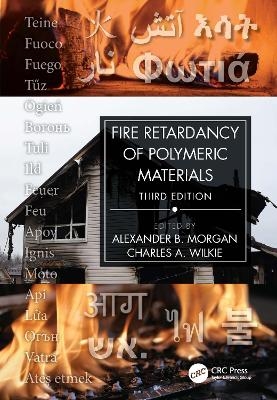
Fire Retardancy of Polymeric Materials
CRC Press (Verlag)
978-1-032-45754-3 (ISBN)
Detailed study and consideration of chemistry, physics, materials science, economic issues and fire safety science is necessary to address considerations of mechanical, thermal, environmental, and end-use requirements on top of fire protection means that the field requires. This thoroughly revised new edition continues to offer comprehensive coverage of the scientific approach for those developing fire safe materials. It covers new topics such as bio-based materials, regulatory issues, recycling, newer flame retardant chemical classes, and more details on how to flame retard materials for specific market applications.
Written by a team of experts, this book covers the fundamentals of polymer burning and combustion and how to apply fire protection or flame-retardant chemistries to specific material classes and applications. The book is written for material scientists and fire safety scientists who seek to develop new fire safe materials or understand why materials burn in our modern environment.
Features
Connects fundamentals of material flammability to practical fire safety needs
Covers current fire safety requirements and regulations affecting flame retardant selection
Provides information on chemical structure-property relationships for flame retardancy
Provides practical guidance on how to design fire safe materials for specific fire risk scenarios
The new edition is expanded to 32 chapters and all chapters are updated and revised with the newest information
Alexander B. Morgan received his B.S in Chemistry from Virginia Military Institute in 1994 and his Ph.D. in Chemistry from the University of South Carolina in 1998. Dr. Morgan has over twenty-seven years of experience in the areas of materials flammability, polymeric material flame retardancy, fire science, fire testing, thermal decomposition chemistry, and fire safety engineering with an emphasis on chemical structure property relationships and fire safe material design. He has helped academic, government, and industrial customers solve their flame retardant and fire safety needs in a wide range of applications. Dr. Morgan is on the editorial review board for Fire and Materials, and is the Editor-in-Chief for the Journal of Fire Science. He is also a member of ASTM, Sigma Xi, the International Association of Fire Safety Scientists, and the American Chemical Society. His current research areas include: New Flame Retardant Technology with Reduced Environmental Impact for Electronics, Building Materials, Bedding/Furniture, Wire & Cable, Transportation, Textiles. Fire Testing Method Development Fire Safety / Survivability for Aircraft and Ground Vehicles Materials Development, and Technology Assessment for Additive Manufacturing for Aerospace Applications Charles A. Wilkie received his BS degree in Chemistry from the University of Detroit in 1963 and his Ph.D. in Inorganic Chemistry from Wayne State University in 1967. He subsequently joined Marquette University as an Assistant Professor and rose through the ranks until retiring in 2009; he now is Professor Emeritus. In 1978, he read a paper on phosphorus-based flame retardants and decided to move into that area. He has worked in the field of flame retardancy for more than 30 years. His initial work was to attempt to understand mechanistically how a flame retardant interacts with a polymer. His research group also did quite a bit of work on nano-composite based flame retardancy. Wilkie has served, and continues to serve, on the editorial boards of several journals and has been involved with organizing several meetings in this area.
1. An Introduction to Materials Flame Retardancy and Fire Protection. 2. Thermal Decomposition of Flame Retardant Polymers. 3. Physical Parameters Affecting Fire Growth. 4. Halogen Containing Flame retardants. 5. Phosphorus-Containing Flame Retardants. 6. Flame Retardant Fillers. 7. Intumescence-based flame retardants. 8. Silicon and Inorganic Flame Retardants. 9. Boron-Based Flame Retardants. 10. Nitrogen-Based Flame Retardants. 11. Non halogen radical generators for enhanced flame retardancy of plastics. 12. Polymer Nanocomposites. 13. Bio-based flame retardants. 14. Conformal Flame Retardant Coating Systems. 15. Flame Retardants without Conventional Flame-Retardant Elements. 16. Multi-component Flame Retardant Systems. 17. Uses of Fire Tests for Flame-Retardant Material Development. 18. Material Flammability Measurements and Test Methods. 19. Fire Emissions and Smoke Toxicity. 20. Toward a Quantitative Relation between the Molecular Structure and Fire Growth on Polymeric Solids. 21. Full-Scale Fire Modeling and Simulation. 22. Regulations, codes, and standards relevant to fire issues in the United States. 23. Chemical Regulation of Flame Retardants. 24. Recycling of Flame Retardant Polymeric Materials: State of the Art and Future Perspectives. 25. Flame Retardant Design and Protection for Fiber-Reinforced Composites. 26. Flame Retardant Design and Protection for Wood and Wood Products. 27. Flame Retardant Design and Protection for Textiles. 28. Flame Retardant Design and Protection for Electrical and Electronic Systems. 29. Flame Retardant Design and Protection for Wire and Cable. 30. Flame Retardant Design and Protection for Building Materials. 31. Flame Retardant Design and Protection for Furniture and Furnishings. 32. The Future of Material Fire Protection – Unmet Needs, New Fire Risk Scenarios, and New Flame Retardant Approaches.
| Erscheinungsdatum | 22.08.2024 |
|---|---|
| Zusatzinfo | 99 Tables, black and white; 369 Line drawings, black and white; 75 Halftones, black and white; 444 Illustrations, black and white |
| Verlagsort | London |
| Sprache | englisch |
| Maße | 210 x 280 mm |
| Gewicht | 1640 g |
| Themenwelt | Naturwissenschaften ► Biologie ► Ökologie / Naturschutz |
| Naturwissenschaften ► Physik / Astronomie | |
| Recht / Steuern ► Strafrecht ► Kriminologie | |
| Technik ► Umwelttechnik / Biotechnologie | |
| ISBN-10 | 1-032-45754-6 / 1032457546 |
| ISBN-13 | 978-1-032-45754-3 / 9781032457543 |
| Zustand | Neuware |
| Informationen gemäß Produktsicherheitsverordnung (GPSR) | |
| Haben Sie eine Frage zum Produkt? |
aus dem Bereich


